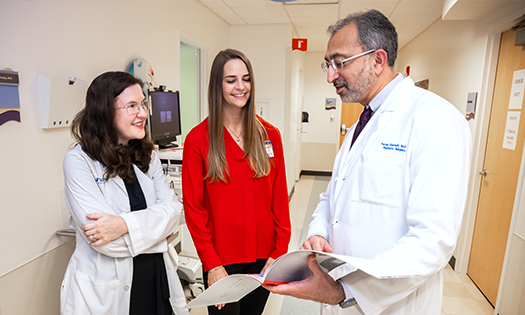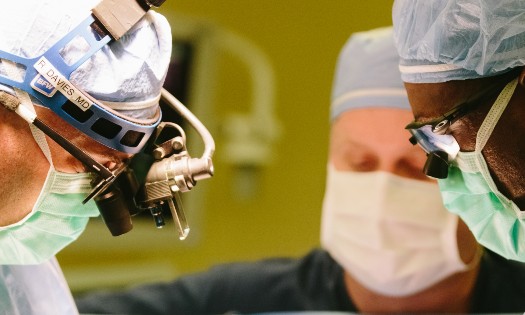Children’s Medical Center Dallas, part of Children’s Health℠, is one of only two medical centers in the country that has pediatric cardiothoracic surgical teams routinely using three-region perfusion during the Norwood procedure and aortic arch repairs. This groundbreaking technique is believed to significantly reduce postsurgical complications and improve survival outcomes for infants with certain types of congenital heart disease.
Three-region perfusion supplies a continuous flow of oxygenated blood to all vascular beds in a patient’s upper and lower body, as well as the heart. It’s also called beating-heart Norwood procedure because surgery takes place while the heart is beating.
Nicholas Andersen, M.D., Pediatric Cardiothoracic Surgeon, helped develop this perfusion technique in 2020. “The Norwood procedure is one of the riskiest, most complex pediatric heart surgeries we perform,” says Dr. Andersen. “Nationally, about 1 in 6 infants who undergo it don’t survive.”
Since joining Children’s Health in 2023, Dr. Andersen has performed more than 20 heart surgeries using three-region perfusion with 95% patient survival. Dr. Andersen serves as Director of the Complex Biventricular Repair Program and Surgical Co-Director of the Cardiovascular Intensive Care Unit (CICU) at Children’s Health. He’s also an Associate Professor of Pediatric Cardiothoracic Surgery at UT Southwestern.
Here’s a look at how three-region perfusion works and its many benefits.
Lowering Norwood procedure risks
The standard Norwood procedure involves placing a medically fragile infant into deep hypothermia to protect their organs while a surgeon operates on a temporarily arrested heart. Typically, a perfusion machine circulates blood to the upper part of the patient’s body, but not to the heart or lower body. This lack of blood flow increases the risk of ischemia, organ damage and other life-threatening events.
Three-region perfusion circumvents these risks by providing uninterrupted blood flow to a patient’s:
Brain and upper extremities
Lower extremities, including kidneys and lungs
Heart, which never experiences cardiac arrest
This perfusion approach is beneficial for patients with single ventricle defects, such as hypoplastic left heart syndrome (HLHS), who need the Norwood procedure. It’s also used during aortic arch repairs for extended coarctations of the aorta and interrupted aortic arch.
Key elements of 3-region perfusion
The sustained total all region (STAR) perfusion Dr. Andersen originally helped develop requires two perfusion arterial pumps. “With some modifications to the circuit and a split arterial cannula line, we can perfuse all three regions using one arterial pump,” says Richard Ginther, Jr., Certified Clinical Pediatric Perfusionist at Children’s Health and Faculty Associate of Pediatric Cardiothoracic Surgery at UT Southwestern. “This approach is simpler, and our data shows it provides similar, if not better, outcomes.”
Key components of three-region perfusion include:
Warmer body temperature. The team induces mild hypothermia (approximately 32 degrees Celsius), which is about 10-14 degrees warmer than deep hypothermia needed for traditional Norwoods. “It takes less time to cool and rewarm a patient, so surgery and anesthesia time take about 4 hours instead of the usual 6-8 hours,” says Dr. Andersen.
Modified aortic clamp. During the operation, Dr. Andersen uses a specially designed aortic clamp that has an opening for the perfusion cannula. “We can clamp the aorta without stopping blood flow to any region,” he says. “It’s a significant improvement over vessel snares that don’t allow manipulation of the descending aorta.”
Continuous patient monitoring. The perfusion team uses head and flank near-infrared spectroscopy (NIRS) to monitor tissue oxygenation. There’s also continuous electrocardiogram (ECG) monitoring for ST-segment changes or arrhythmias. Upper and lower mean arterial pressure (MAP) is also monitored to facilitate arterial pump flow settings.
Improved outcomes and survival rates. Infants who get heart surgery using three-region perfusion tend to recover faster with fewer post-operative complications. “Postoperatively, we’ve seen a marked decrease in myocardial ischemia, kidney damage and other issues because the heart never stops and blood continuously flows throughout surgery,” says Matthew Lemler, M.D., Pediatric Cardiologist at Children’s Health and Professor of Pediatrics at UT Southwestern Medical Center.
Dr. Andersen adds, “Our CICU recovery metrics are the best in the country in terms of how quickly patients recover from surgery and get off ventilation.” This chart captures metrics from the first 11 patients who had three-region perfusion at Children’s Health:
3-region perfusion Norwood at Children’s Health | |
Total Surgical time | 4.4 hours |
Cardiopulmonary bypass time | 120 minutes |
Cross-clamp time (heart) | 0 minutes |
Selective cerebral perfusion time | 5 minutes |
Circulatory arrest time | 0 minutes |
Time to extubation | 3.5 days |
Time to chest closure | 1.8 days |
Peak lactate | 4.3 mmol/L |
Lactate normalization time | 20.5 hours |
Peak creatinine | 0.8 mg/dL |
Postoperative ECMO | 0 patients |
CICU length of stay | 14 days |
Total hospital length of stay | 34 days |
Why Children’s Health: Leaders in pediatric cardiology and cardiothoracic surgery
Three-region perfusion is a safe technique that improves outcomes without compromising quality indicators. Children’s Health continues to collect data for research – and is
among the nation’s top-ranked medical centers for pediatric cardiology and cardiothoracic surgery. “Children with single ventricle defects have at least two more heart surgeries ahead of them, usually more during their lifetimes,” says Dr. Andersen. “It’s important that they go into each surgery with a strong heart, kidneys, lungs and body. Their chances of doing that are greater with three-region perfusion.”
Learning to perform the Norwood procedure or aortic arch repairs on a small, beating heart adds to surgical complexity. But thanks to continuous perfusion to all vascular beds, pediatric cardiothoracic surgeons have more flexibility and time to complete repairs with less risk of ischemic damage. “We welcome the opportunity to help others learn and safely implement three-region perfusion for heart surgeries,” says Dr. Andersen.
Learn more about our innovations in pediatric cardiology at Children's Health.


